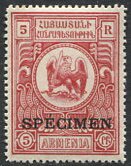Stamp: Country crest, eagle (Specimen) (Armenia 1920)
Country crest, eagle (Specimen) (Armenia 1920)
01 November (Armenia ) within release Parisian issue postage stamps of Armenia goes into circulation Stamp Country crest, eagle (Specimen) face value 5 Armenian ruble
| Stamp Country crest, eagle (Specimen) in catalogues | |
|---|---|
| Colnect codes: | Col: AM 1920-07 |
Stamp is vertical format.
Rare. Not issued. On a limited number of stamps with denominations of 1, 3, 5, 10 and 15 rubles, the printing house overprinted the word "SPECIMEN". These stamps were intended to be sent to Switzerland to the Universal Postal Union (UPU), to which in October 1920 an application was submitted for the admission of Armenia to the membership of this Union. However, due to the change of government, the question of Armenia's accession to the Universal Postal Union was dropped, and stamps with the overprint "SPECIMEN" also entered the foreign philatelic markets.Also in the issue Parisian issue postage stamps of Armenia:
- Stamp - Country crest, eagle (Specimen) face value 1;
- Stamp - Country crest, eagle (Specimen) face value 3;
- Stamp - Country crest, eagle (Specimen) face value 5;
- Stamp - Country crest, eagle (Specimen) face value 10;
- Stamp - Country crest, eagle (Specimen) face value 15;
- Stamp - Mount Ararat face value 100;
- Stamp - Spinner face value 40;
- Stamp - Spinner face value 40;
- Stamp - Spinner face value 70;
Stamp Country crest, eagle (Specimen) it reflects the thematic directions:
A coat of arms is an heraldic visual design on an escutcheon (i.e. shield), surcoat, or tabard. The coat of arms on an escutcheon forms the central element of the full heraldic achievement which in its whole consists of shield, supporters, crest, and motto. A coat of arms is traditionally unique to an individual person, family (except in the United Kingdom), state, organisation or corporation.
Eagle is the common name for the golden eagle, bald eagle, and other birds of prey in the family Accipitridae. Eagles belong to several groups of genera, some of which are closely related. True eagles comprise the genus Aquila. Most of the 68 species of eagles are from Eurasia and Africa. Outside this area, just 14 species can be found—two in North America, nine in Central and South America, and three in Australia.
A symbol is a mark, sign, or word that indicates, signifies, or is understood as representing an idea, object, or relationship. Symbols allow people to go beyond what is known or seen by creating linkages between otherwise very different concepts and experiences. All communication (and data processing) is achieved through the use of symbols. Symbols take the form of words, sounds, gestures, ideas, or visual images and are used to convey other ideas and beliefs. For example, a red octagon is a common symbol for "STOP"; on maps, blue lines often represent rivers; and a red rose often symbolizes love and compassion. Numerals are symbols for numbers; letters of an alphabet may be symbols for certain phonemes; and personal names are symbols representing individuals.




